
© 2010-2022 by Fine Arts of the Southwest, Inc. All rights reserved.
Unauthorized reproduction or use is strictly prohibited by law.
An extraordinary large Hopi polychrome
pottery bowl by Nampeyo with an Abstract Modernist bird design, c.1898-1900
This bowl virtually screams “NAMPEYO” from the rooftops, it has virtually all the defining characteristics
we use to identify and admire her outstanding work. It starts with the graceful elegant shape of this large bowl,
the finely-achieved relatively thin vessel walls and the beautiful all-over long stroke stone polishing. The design is
a classic Nampeyo abstract interpretation and presentation of an ancient Hopi Sikytaki-Period (1375-1625 A.D.) bird figure. The design uses the interplay of positive and negative spaces masterfully, another Nampeyo “Signature” trait and is rendered in black paint and her characteristic streaky red paint.
Then there’s the extra coil of clay under the interior rim and the double unbroken black framing lines surrounding the design field. The two matched painted glyphs around the bowl’s exterior rim are also most beautifully done.
A word about the dating, we place this bowl in the narrow time frame of 1898-1900 as evidenced by the very small remnants of the older style crackled slip characteristic of Hopi Polacca polychrome period pottery (c. 1780–1900) At the very end of the Polacca period when this bowl was made the crackled slip had almost disappeared and there
are a few small sections of it on the interior shoulder and on the bottom of this bowl indicating the end of the stylistic tradition of Polacca Polychrome and the transition to the later Hopi Polychrome, the style which essentially continues to this day.
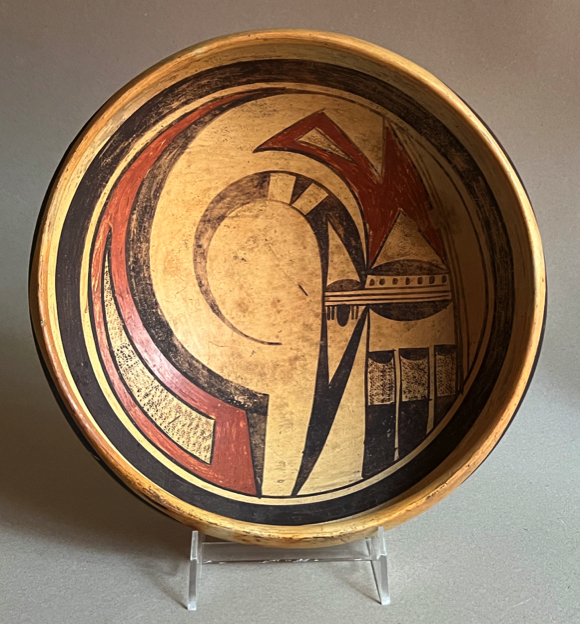
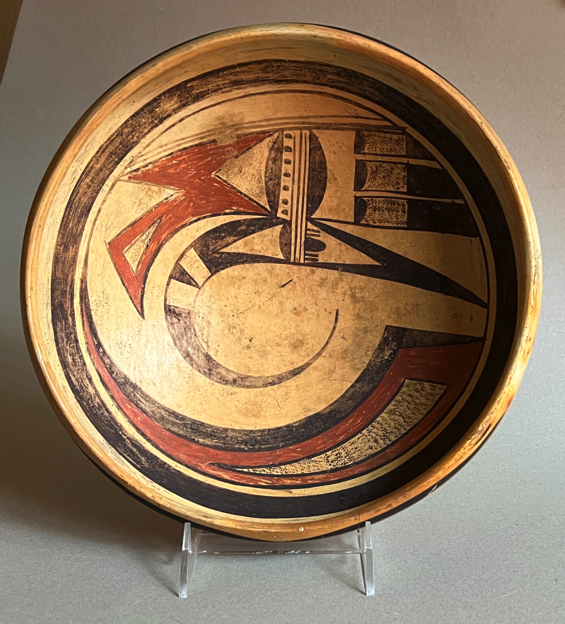
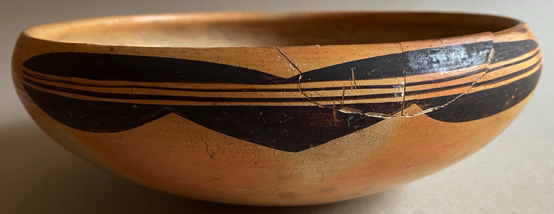
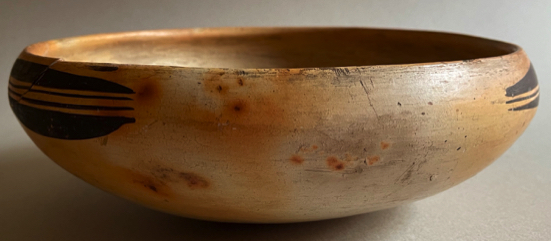
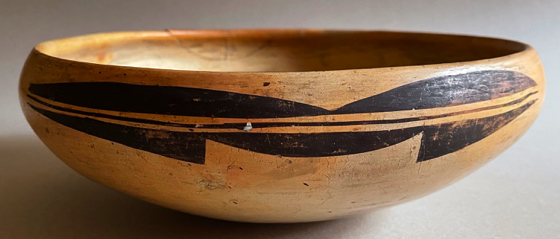

The bowl is even more impressive and compelling now than it was back when Nampeyo made it. It has acquired over the decades the beautiful aura of age, rarity and marvelous patina having survived its perilous and likely arduous journey to arrive at this point in history, its beauty and uniqueness essentially intact after its previous transportation variously by mule and/or horse wagon, then perhaps by railroad, all in the extreme heat and dust of a broiling Southwestern summer or the howling blizzards of a frigid Southwestern winter.
As we mentioned previously, the painted design of the bowl is that of a highly-stylized deconstructed depiction of an Ancient Sikyatki bird, with abstracted feather and pendant tail motifs. The use of positive painted areas in red and black and the interweaving of areas of negative space in and around the design is masterful giving the design a dynamism that makes it seem almost alive. The control of the brush and the paint application itself, particularly in the extreme precision, control and freedom of the linework, are astounding especially considering the primitive materials and techniques used to achieve it.
Even though Nampeyo (1858-1942) never once set foot in an art studio, gallery or museum her entire life
and even though she stood barely five feet tall, she is an astounding and original giant of modern art, towering shoulder-to-shoulder alongside Picasso, Bracque, Kandinsky, Miro, DeKooning and Pollock not to mention numerous others. And when you consider the primitive circumstances under which she created her magnificent artworks, sitting outside in the dirt under the blazing sun, in the constantly howling wind and dust and unrelenting heat and freezing cold, having to find and create all her own art materials herself, her achievements become all the more remarkable. Could Nampeyo herself have influenced the direction of Modern Art? Many early Nampeyo pottery pieces were collected by and exhibited in prominent European museums where they might possibly have been seen by these
and many other artists.
Just imagine for a moment if Pablo Picasso had had to paint his famous “Demoisselles D’Avignon” not in the relative civilization of a Paris art studio with a cafe on every corner of the neighborhood but while sitting on his knees in the hard dirt hundreds of miles out in a remote isolated desert using paints he had to hand grind from local plants and minerals he had to search for and find himself, paint only with brushes he had to make from chewed yucca stem fiber on cobbled together scraps of canvas he scavenged from old army tents. Could he have even done it? And what would it have looked like if he had?

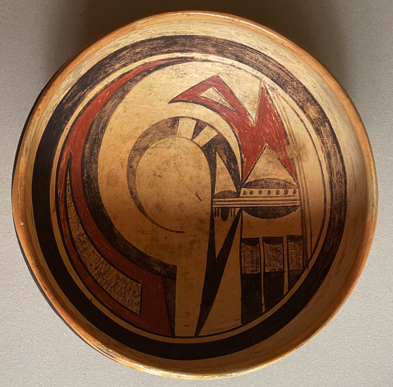
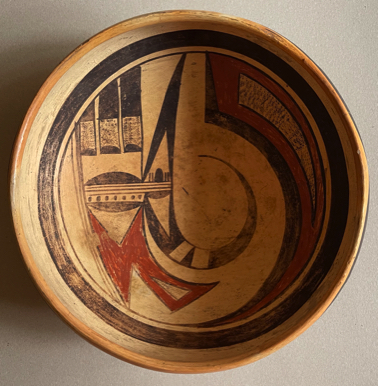
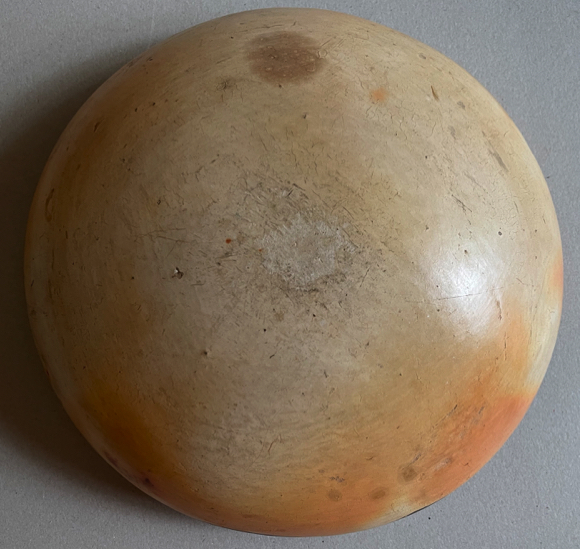
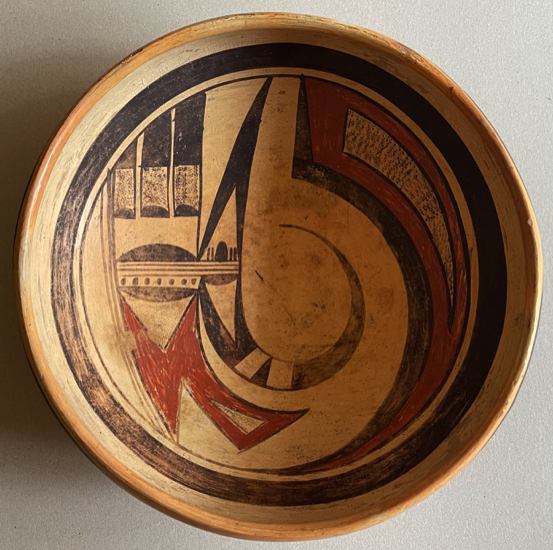
At left and right, two examples of Nampeyo bowls with stylized Sikyatki type bird and feather designs. At center, image of a Hopi Sikyatki Polychrome “Man-Eagle” Bowl excavated at Sikyatki Village by Jesse Walter Fewkes, Smithsonian Institution Sikyatki Expedition, 1895.
Center Illustration source and © "Prehistoric Hopi Pottery Designs" by Jesse Walter Fewkes, Dover Books, 1973, pp. 59. Right photo source and © Alamy Stock Photo
The bowl measures a considerable 11” in diameter and it is 3 3/4” in height. It is in extremely good condition, particularly for its 120-125 years of age. There is absolutely no restoration or overpainting in evidence anywhere
on the bowl under ultra-violet light examination. There is a certain degree of overall abrasion wear and some evidence of deposits to the bowl’s interior and it certainly appears as if this is ethnographic wear from use. There are two small pieces broken out of the bowl’s rim which have been re-glued back in. We do not find this small repair visually distracting particularly when the bowl is viewed from the front and the repair itself is quite stable but if it’s bothersome, it could be easily repaired by a qualified professional pottery restorer for $350-$450 at most.
Overall, the piece is remarkably intact in our view and we would recommend leaving it exactly “as is”.
This bowl is a simply astonishing, original and daringly modern artwork, made that much more so by the extreme circumstances of its creation. By virtue of its unique, powerful, starkly Modernist composition and its overall artistic beauty. It could easily be exhibited in a vitrine in the Museum of Modern Art taking its deserving place next to a Brancusi sculpture under a Picasso or Pollock painting in the company of its distinguished compatriots, fellow giants in the world of Modern Art.
SOLD


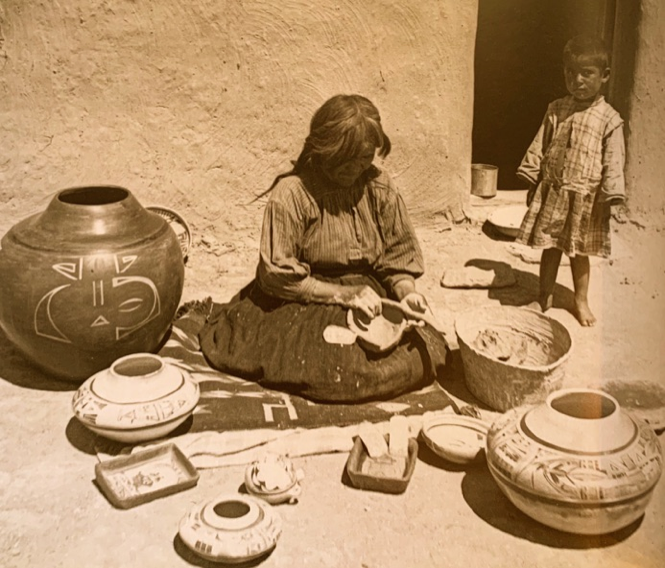
"Mrs. Nampeyo, an acknowledged best Hopi indian woman Pottery maker 1st Mesa Hopiland, Ariz. Sichomovi."
R. Raffius, 1905 photo source and © Keystone-Mast Collection, UCR/California
Museum of Photography, University of California, Riverside
“When I first began to paint, I used to go to the ancient village and pick up
pieces of pottery and copy the designs. That is how I learned to paint. But now,
I just close my eyes and see designs and I paint them.”
-Nampeyo
